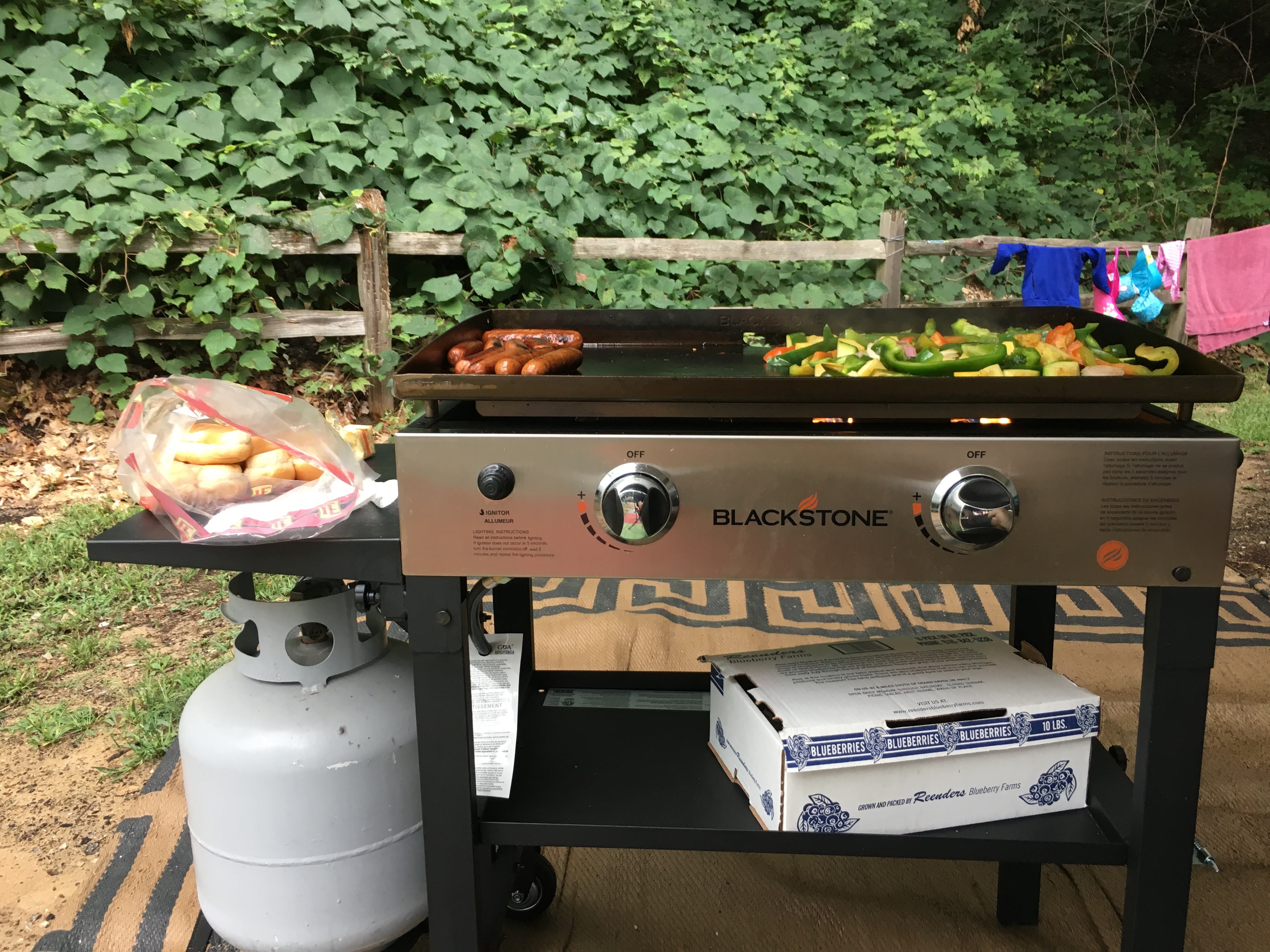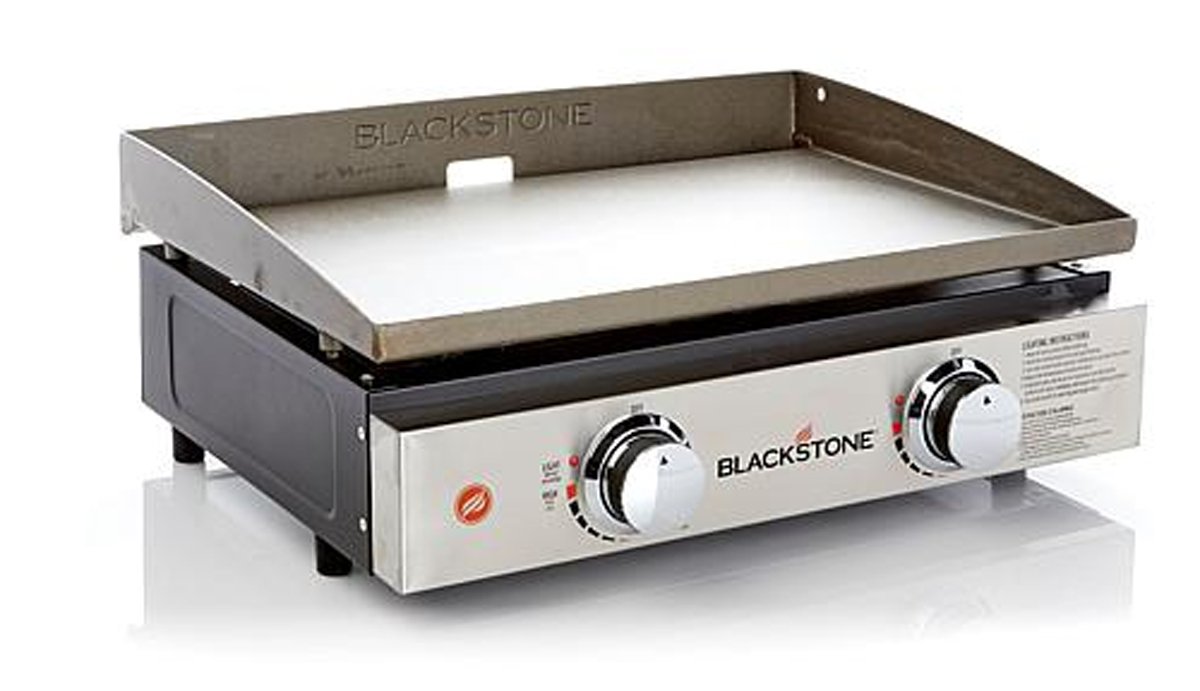When we say griddle, we mean a very specific type. There are a myriad of griddles from the large flat-top professional versions you see in most restaurants, to the tiny electric ones that we’ve all cooked on.
Here when we say griddle, we mean a propane fire heated flat top of cold-rolled steel. It’s an outdoor tool, like a grill, and is geared towards home use.
The Outdoor Propane Griddle

A Griddle is essentially a large flat thick slab of cold rolled steel suspended over a propane burner. It’s merely a large surface that gets hot. But somehow that simple idea translates into a near perfect tool for meal prep.
You can crank up the heat anywhere from a warm slow cook to a ridiculously hot sear-worthy temperature. It uses your standard propane connections, and has a holder for a 20lb tank. It is designed to live outside, on your deck, porch or garage. And it is magical. Grilled cheese perfection. Philly Cheese Steak. Smash burgers. grilled veggies. Ground beef. Chorizo. Chopped chicken. Pancakes.
History
Flat top cooking has been around for a very long time. According to my quick internet search, the first flat-top cooking was done in Central and South America on circular clay griddles used to cook corn dough. This is not new, people.
Fast forward hundreds of years, and we’ve been using flat-top cooking in nearly every restaurant in the world. You can buy hundreds of styles of flat-top griddles for commercial use from restaurant supply stores. This is a tool that has been in R&D for a very long time.
Restaurants love it for the even-heating, and predicable cooking. It makes delicious food in a repeatable manner that’s easy to clean up, and provides excellent results. Why wouldn’t we take advantage of this technique at home?
Today’s Grill Griddle
The at home griddles being produced today typically have between one and four linear burners positioned several inches below the steel surface. Most companies are making them with a substantial lip on three or four sides to contain the food (which is really helpful when removing it from the cooking surface or pushing it to the side). There are a few strategies for capturing the excess grease and oil from cooking. The latest strategy is the rear-grease trap by Blackstone. Before that everyone did a channel along the front of the griddle that dripped into a removable container. (Worlds better than the awkward grease trap in a propane grill).
You’ll find Griddles with tops in the range of 17 inches wide to 36 inches. There are a few outliers with six burners, and even wider tops, but those tend to be specialty offerings.
The 36 inch models are the most popular, with many loud internet personalities saying it’s the only way to go. Go big or go home. You’ll end up with the big one anyway. Etc… (note: I went with the slightly smaller 28″ version)

The smaller griddles tend to be table-top versions, and have adapters for the smaller propane canisters, or the standard 20lb propane tank. The Blackstone 17″ and 22″ griddles are a classic example of this small form factor

Some call it a “Griddle Grill” or just plain old “Griddle”. I’ve heard “Grill Griddle”, “Propane Flat Top”. Most people who are unfamiliar with it don’t quite know what to call it! We’ll refer to it just with the single word “Griddle”, acknowledging that it meant something else historically, and that we’re hijacking the term for this new thing.
This new class of back yard grilling machines hit the broader market a few years ago, hot on the tail of the big green egg. The green egg fit into our grilling lexicon. It was something we already had, but better. The griddle was something totally new and foreign. It has taken longer to catch on. However, backyard chefs around the US have been discovering the benefits of a large slab of hot steel. Let’s talk about that.
In the commercial world it’s also known as a “Flat Top Grill“. Short order restaurants, and food trucks around the globe have been using a large flat top of cold rolled steel to prepare culinary delights for decades. It’s a super effective tool to prepare a broad variety of foods on. It seals in flavor. It steams. It sears. it makes perfect pancakes, and killer omelets. It’s the go-to-tool for most dry-heat preparations. For a long time it was out of reach for most home chefs. A commercial grade flat top grill starts at $800 for the smallest version, and can easily top $10,000. Those are designed for indoor use, which requires adequate ventilation, and can heat up a room quick – both of which are out of reach for a typical homeowner.
Queue the innovators. There seems to be a wave of restaurant tools making their way into homes lately. Sous-Vide cooking is a particularly popular, and quite effective tool that has recently captured the hearts of precision chefs everywhere. Sous-vide cooking was first dreamed up in 1799 and pioneered in the late 1970’s in restaurants in France. It took nearly fifty years for us to get proper tools to participate in this remarkable way of cooking. Smoke Guns have made delicious smokey flavor more accessible. Instant-Pot’s have brought digitization and control to the world of pressure cooking.
Now you can add at home “Gas Griddle” to the list.
The gas Griddle innovators have approached a place of reverence in the US. The backyard barbecue is a sacred place for many, with longstanding traditions. Get someone started on their preference for charcoal vs gas and you’ll have a conversation for the afternoon. So it’s no surprise that a propane griddle is still waiting to find it’s place in our homes. The Griddle is so simple, and so effective that I can only guess it’s the traditions holding it back. I suspect you’ll see them more and more often at your neighbors and friends cookouts in the near future!